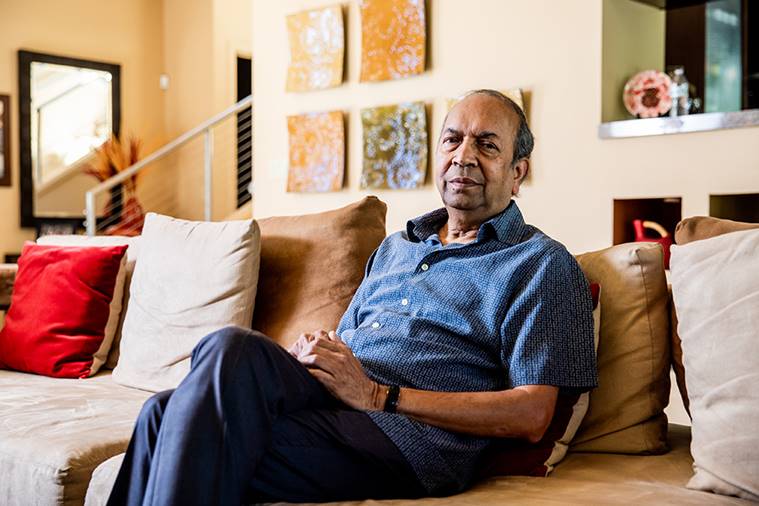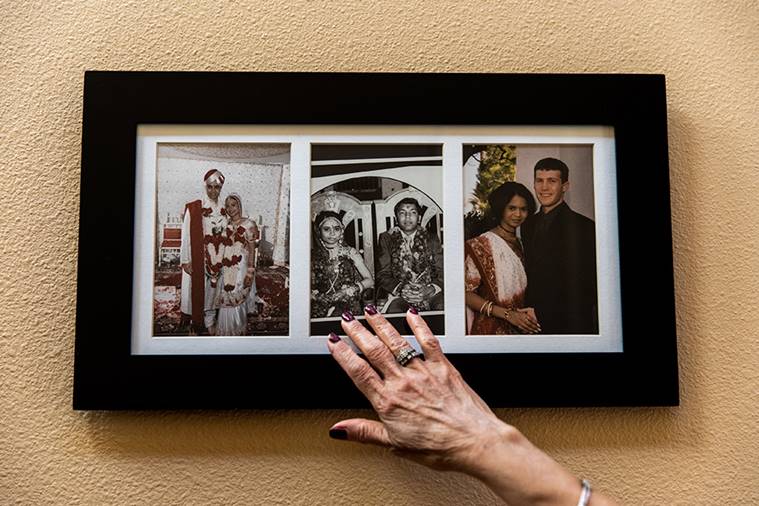One face of immigration in America is a family tree rooted in Asia
The Donald Trump administration is pushing policies supposedly intended to favor immigrants who have valuable skills at a time when newcomers already are, on average, at their most educated.

Amita Patel holds a photo of her family, at her home in Las Vegas, Sept. 14, 2018. More of the United States population is foreign-born now than at any time since 1910, and many immigrants came through family reunification policies that the Trump administration hopes to scale back. (Photo: Roger Kisby/The New York Times)
The young engineer arrived in America when he was 23 with a good education and little else. He landed a job at a nuclear test site, and built a home in Nevada. Between the 1970s and the mid-1980s, he brought his wife, mother, five sisters and a brother over from India, his native land.
In later years, his siblings sponsored family members of their own, and their clan now stretches from Nevada to Florida, New Jersey to Texas — more than 90 Americans nurtured on the strength of one ambitious engineer, Jagdish Patel, 72.
44s

'Undocumented migrants are not criminals'
Immigration raids are having a profound impact on entire communities across America.
In late June, four generations of Patels assembled for a reunion in Las Vegas, a gathering that included a venture capitalist, a network engineer, physicians, dentists and students.
“I am so glad that I came to America,” Patel said recently, sitting in the luxurious custom-designed house he built in Las Vegas, complete with a home theater where he hosts Super Bowl parties and a marble-lined Hindu temple room. “I brought everyone here,” he said, “and we have provided valuable service to this country.”
The share of the US population that is foreign-born has reached its highest level since 1910, according to government data released last week. But in recent years, the numbers have been soaring not so much with Latin Americans sweeping across the border, but with educated people from Asia obtaining visas — families like the Patels, who have taken advantage of “family reunification” provisions that have been a cornerstone of federal immigration law for half a century.
Since the Patels began flocking to America in the 1970s, millions of other Indians have arrived to work as programmers and engineers in Silicon Valley, doctors in underserved rural areas and researchers at universities. Most were sponsored by relatives who came before them. Others arrived on work visas and were later sponsored for legal residency, or green cards, by their employers.
The Trump administration has framed immigration as a threat to the nation’s security and to American workers, a dramatic departure from the longtime consensus that immigration was a net positive for the country. The president’s public priorities have often focused on fortifying the southwest border, but his administration is also working to scale back decades of legal migration that have led to Asians, not Latin Americans, becoming the largest group of new foreign-born residents since 2010.
Already, the administration has quietly begun taking steps to cut back legal immigration, under the banner of “Buy American and Hire American,” which the president framed in an executive order last year. Some experts predict that the number of immigrants granted permanent legal residency in the 2018 fiscal year, which ends Sept. 30, will show a rare decline.
Without passing new legislation, the administration has pursued a number of policies that are slowing legal immigration. It has reduced refugee admissions; narrowed who is eligible for asylum; made it more difficult to qualify for permanent residency or citizenship; and tightened scrutiny of applicants for high-skilled worker visas, known as H-1Bs.
A recent analysis of government data by the National Foundation for American Policy, a nonpartisan research group, found that the denial rate for H-1B visa petitions had jumped by 41 percent in the last three months of the 2017 fiscal year, compared with the previous quarter. Government requests for additional information on applications doubled in the same period.
Green-card applicants sponsored by an employer now must undergo in-person interviews, a step that previously was taken only in cases that raised concerns.
The Trump administration is pushing policies supposedly intended to favor immigrants who have valuable skills at a time when newcomers already are, on average, at their most educated. Nearly half of all foreign-born people who have arrived since 2010 have college degrees, compared with about 30 percent of native-born residents.
“We are having this debate about getting our system to be merit-based, but it really in effect already is one,” said David Bier, an immigration policy analyst at the Cato Institute in Washington, D.C. “The least-known fact about legal immigration to the U.S. is that it’s much more educated than the general US population.”
Of the 1.1 million green cards granted in 2017, about two-thirds went to people sponsored by relatives, compared to just 12 percent who were sponsored through employment.
Immigration has taken center stage in many Republican election campaigns this year. Rep. Ron DeSantis, the party’s candidate for governor of Florida, released a video in which he tells his daughter to “build the wall” as she plays with blocks. Brian Kemp, the Republican nominee for governor of Georgia, ran an ad saying he would “round up criminal illegals” in his pickup truck.
“The big story here is just the massive misperception about the nature of immigration in the US,” said Edward Alden, senior fellow at the Council on Foreign Relations, who specializes in immigration policy. “The lion’s share of public attention is focused on what is now a very small number of people coming here illegally and showing up at the border seeking asylum.
“The reality is that a growing percentage of immigrants coming to the U.S. are highly educated, and are exactly the sort of people we want to be attracting.”
Supporters of President Donald Trump’s position say that this trend is an incidental result of a policy that does not guarantee such an outcome.
“We need to construct a system that discourages endless chains of relatives coming in,” said Mark Krikorian, executive director of the Center for Immigration Studies, which supports curbs on immigration. “We have an immigration system that rewards people who have relatives in the United States, rather than people who have skills and education.”
Michael Bars, a spokesman for US Citizenship and Immigration Services, the agency which is focusing most of the new scrutiny on legal immigration, said the government’s aim is not to close the borders but to protect against fraud, human trafficking and gang activity, “defending our system from those seeking to exploit it at the expense of US workers, lawful-abiding applicants and petitioners.”
There are still an estimated 11 million people in the country illegally, and that represents a major political issue.
“Eleven million people is not a small number,” said Jeffrey Passel, senior demographer at the Pew Research Center. “But it is certainly the case that unauthorized immigration from Mexico is getting a lot more attention than the numbers seem to warrant.” Passel said fewer Mexicans were caught at the border in fiscal 2017 than in any year since the late 1960s.
Under the Trump administration’s plan, the number of family-based green cards issued would be reduced from the 804,793 granted in 2016 to about 487,000 a year, according to an analysis by Julia Gelatt and Sarah Pierce of the Migration Policy Institute — a 40 percent reduction in family-tied green cards and a 27 percent reduction overall.
“Trump is the first of any modern president to advocate for reducing legal immigration,” Pierce said.
Currently, U.S. citizens like Patel can sponsor minor children, unmarried and married adult children, and spouses, parents and brothers and sisters. Green-card holders are limited to sponsoring minor children and unmarried adult children.
Under the new proposal, Americans would lose the right to petition for their parents, adult or married children, or siblings; they could sponsor only spouses and minor children. Green-card holders would be limited further, to sponsoring minor children only, not adult children.
The current system dates to 1965, when Congress passed the Immigration and Nationality Act, which wiped away the old system of country quotas established in the 1920s that many considered racist. The idea was to treat people from all countries equally, and the law’s central pillar was to give U.S. citizens the ability to invite family members who were abroad. It also allowed for some immigration based on skills.
Some experts argue that the real implications of the 1965 law are only now dawning on the wider population, as the face of the country changes — and that realization is what has been driving much of the emotion in politics.
“The 1965 act really changed the look and feel of the country in a fundamental way, but it took 50 years for the country to come to terms with that,” said Muzaffar Chishti, director of the New York office of the Migration Policy Institute.
Madeline Hsu, a professor of Asian-American studies at the University of Austin, Texas, said there were only about 12,000 Indian immigrants in the United States in 1960. The foreign-born Indian population last year stood at about 2.6 million, according to the Brookings Institution, and it had risen by almost half since 2010.
The 1965 law opened up the United States to people from India like Patel.
He recalls that at his engineering college back in the Indian state of Gujarat, “when America started to allow people from different countries to come, we all decided to get ready to go.”
Patel immigrated in 1968 and enrolled at Youngstown State University in Ohio, where he earned a master’s degree in structural engineering. He returned in 1971 to marry, and because he had a green card, he was able to sponsor his wife, Amita.
In 1977, he became a U.S. citizen, and sponsored his brother Jay and Jay’s wife for green cards. By 1985, he had also sponsored his mother, five sisters and their husbands and children, most of whom settled in the New York-New Jersey area.
And he had U.S.-born children of his own. His son, Satya, is now a venture capitalist in San Francisco, after working as an executive at Google and Twitter; his daughter, Sita Montgomery, is an interior designer in Salt Lake City with 140,000 followers on Instagram.
Now retired, Patel savors time to play golf and travel — so far, he has visited 50 countries. He devoted a year to planning the Patel reunion in June.
The eldest Patel to attend the event, which included bowling, banquet dinners and a talent show, was 88; the youngest was 9 months old. Patel gave each attendee a royal-blue booklet, its cover emblazoned with a crown and the words “Royal Patel Family Reunion.” Its pages depict the sprawling Patel family tree, starting in India.
“In America, you can still succeed as an immigrant, irrespective of skin color, religion or country of origin,” said Patel, who likes to point out that Trump’s wife, Melania, sponsored her parents to come to the country she has adopted.
“All this Twitter and campaign stuff is mostly just talk,” he said. “Trump knows in his mind that immigration works. Family reunification will stay.”
MORE VIDEOS
For all the latest World News, download Indian Express App


 Jagdish Patel at his home in Las Vegas, Sept. 14, 2018. More of the United States population is foreign-born now than at any time since 1910, and many immigrants came through family reunification policies that the Trump administration hopes to scale back. (Roger Kisby/The New York Times)
Jagdish Patel at his home in Las Vegas, Sept. 14, 2018. More of the United States population is foreign-born now than at any time since 1910, and many immigrants came through family reunification policies that the Trump administration hopes to scale back. (Roger Kisby/The New York Times) Jagdish Patel at his home in Las Vegas, Sept. 14, 2018. More of the United States population is foreign-born now than at any time since 1910, and many immigrants came through family reunification policies that the Trump administration hopes to scale back. (Roger Kisby/The New York Times)
Jagdish Patel at his home in Las Vegas, Sept. 14, 2018. More of the United States population is foreign-born now than at any time since 1910, and many immigrants came through family reunification policies that the Trump administration hopes to scale back. (Roger Kisby/The New York Times) Amita Patel points to a photo collage of her family, at her home in Las Vegas, Sept. 14, 2018. More of the United States population is foreign-born now than at any time since 1910, and many immigrants came through family reunification policies that the Trump administration hopes to scale back. (Roger Kisby/The New York Times)
Amita Patel points to a photo collage of her family, at her home in Las Vegas, Sept. 14, 2018. More of the United States population is foreign-born now than at any time since 1910, and many immigrants came through family reunification policies that the Trump administration hopes to scale back. (Roger Kisby/The New York Times)













































No hay comentarios:
Publicar un comentario